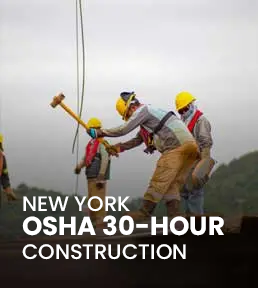Pressure Vessel Safety
Practice Test
Pressure Vessel Safety Quiz
Complete this quiz to earn an exclusive Certificate of Completion from OSHAOutreachCourses.com. Read all the questions carefully and mark the right answers to earn the perfect score. Best of luck!
Total Questions: 5
Why Workers Choose Us
| features |  |
other providers |
|---|---|---|
| Instant Downloadable Certificate | ||
Free Study Guide

|
||
Discounts For Businesses

|
||
| No Hidden Cost | ||
Mobile Compatibility

|
||
Flexible Learning

|
Satisfied Customers
Learning Objectives
- Distinguish how pressure vessels are categorized and regulated.
- Identify appropriate safety measures when handling, installing, operating, servicing and inspecting pressure vessels.
- Recognize potential hazards when visually inspecting pressure vessels.
Course Outline
-
1. Introduction
- Welcome
- Introduction
-
2. Categorization and Regulations
- Types of Pressure Vessels
- Pressure Vessel Design
- Codes and Standards
- Markings
- Knowledge Check: Categories
- Knowledge Check: Safety Codes
- Knowledge Check: Design and Markings
-
3. Failures and Hazards
- Failures
- Hazards
- Knowledge Check: Hazards
-
4. Safety Measures
- Personal Safety
- Pre-Operation Safety Procedures
- Safe Operating Procedures
- Pre-Maintenance Safety Procedures
- Maintenance Procedures
- Knowledge Check: Vessel Failures
-
5. Inspections and Safety Devices
- Routine Inspections
- Safety Devices
- Types of Safety Devices
- Using Safety Devices
- Required Inspections
- NDE Inspection Methods
- Repairs
-
6. Conclusion
- Conclusion
Group Discount for Corporate Accounts

VIDEO TESTIMONIAL
FAQ
What is the pressure vessel design factor of safety?
Why is it necessary for workers to take pressure vessel inspection training courses?
What you will learn in the pressure vessel hazards and control safety course?
What are the common hazards associated with pressure vessels?
What are the measures you should consider to stay safe and prevent pressure vessel failures?
How much does it cost to get pressure vessel certification training?
From where can I get pressure vessel inspection certification?
Job Aid Pressure Vessel Safety PDF
Join our mailing list
Get announcements, industry updates and promotional offers.
17350 TX-249 Ste 220 19204, Houston, TX 77064, United States







